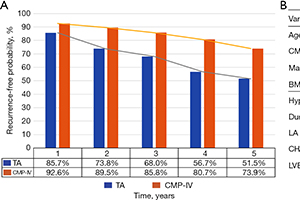Ke Wei, Chunrong Bao, Dongfang Zhao, Junwen Zhang, Ju Mei, Nan Ma
AbstractBackground: Thoracoscopic ablation (TA) has emerged as a promising treatment for atrial fibrillation (AF), with the Cox-Maze IV Procedure (CMP-IV) as the current gold-standard intervention. This study aims to evaluate and compare the outcomes of TA and CMP-IV in treating AF.
Methods: Patients with AF underwent either CMP-IV or TA through a left-side chest approach. The CMP-IV entailed bi-atrium ablation, whereas the TA involved creating three circular plus three linear ablations in the left atrium. We analyzed baseline characteristics, perioperative outcomes and recurrence rates using propensity score matching (PSM) at a 1:1 ratio, to ensure comparability between the two treatment groups.
Results: A total of 459 patients underwent either CMP-IV (n=93) or TA via left chest (n=366) and 174 patients were deemed eligible for 1:1 PSM. The TA group experienced significantly shorter intensive care unit (ICU) and hospital stays. The mean follow-up period was 31.5±22.1 months. Pre- and post-matching analysis showed that CMP-IV had a higher rate of freedom from recurrence compared to TA, particularly in non-paroxysmal AF patients. Multivariable Cox regression analysis revealed that CMP-IV was associated with a reduced risk of recurrence, while an increased left atrial size emerged as an independent predictor of postoperative recurrence, regardless of the use of CMP-IV or TA.
Conclusions: Our study suggests that while the therapeutic efficacy of TA for “lone” AF may fall short of the classic CMP-IV, its less invasive nature results in significantly shorter ICU and hospital stays. To enhance patient outcomes following TA, it is essential to improve the quality of ablation, refine the ablation route, and focus on careful patient selection.

留言 (0)